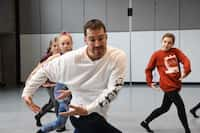Growing up in Dallas, I didn’t identify as Mexican or American, though I’m both. In Spanish we have a saying that goes, “No soy ni de aqui ni de alla.” It directly translates to, “I’m neither from here or from there.” For me, a first-generation Mexican-American, it means never feeling Mexican or American enough. It means belonging to two beautiful cultures yet not fully identifying with either.
My friends at school had another name. They called me a coconut: brown on the outside but white on the inside. My Hispanic friends were always quick to point out that I “spoke like a white girl.” And my white friends would sometimes make fun of the fact that I mispronounced English words like “salmon.”

I felt stuck, confused and alone. I was too white for my Hispanic friends and too Mexican for my white friends.
What’s more, I grew up in Midway Hollow, a neighborhood outside of Preston Hollow, where the average house is priced at $250,000 to $750,000 and 58 percent of our neighborhood is white. Midway Hollow is the kind of neighborhood where everyone knows the neighbors by name and the police knock on your door if your garage door is open. We were the only Hispanics on the block. My family attended a predominantly white Catholic church, where hayrides, fall festivals, and huge Fourth of July picnics were the norm.
I guess we behaved like a typical white family might have. My mom didn’t make tamales, menudo or homemade tortillas. Actually, my idea of tortillas can be found in the Hispanic food aisle at the grocery store. I grew up listening to George Strait instead of Vicente Fernandez. Attending English mass instead of Spanish mass. I was involved in several extracurricular activities: Girl Scouts, YMCA soccer, gymnastics and the Children's Chorus of Dallas, to name a few. My parents were very active in the PTA and Dad’s Club, and college was never an “if you go” but “when you go.” In fact, I took my first SAT in the 5th grade as part of the Duke University's TIP.
I should be proud to have been raised with a fairly privileged lifestyle. We went to Disneyland and I took etiquette classes.
But who was I, really? I was uncomfortable. I wanted to use perfect English around my white friends, perfect Spanish around my Hispanic friends. I was trying to be what other people wanted me to be, not who I desired to be. I hid it with a smile as I developed depression and anxiety. It didn’t help that when I attended the University of Texas, Hispanic friends told me I was the “whitest Mexican” they had ever met. I didn’t want to tell them I’d been to Universal Studios Hollywood more times than I had been to Mexico.
For the first time in my life, I envied how in touch they were with their Mexican side.
In college, a class called History of Mexican Americans in the United States allowed me to look at my culture through the eyes of people like me. I soon realized that my internal conflict wasn’t unique. In fact, the Dallas-Fort Worth population is 39 percent Hispanic, many who might feel just like I do. And so I decided to lean in. I am bicultural.
Instead of feeling embarrassed for mispronouncing a few words, I felt joy at the fact that I could speak two languages fluently. My parents -- a collator operator/handyman and a house cleaner/event planner -- moved to the United States to chase the American Dream. I’m living their dream.
Today, instead of carrying shame for being Mexican-American, I carry a sense of purpose.
I still sing along to Strait, but now I also sing along to Fernandez. I’m involved in organizations like the Dallas Cotillion Club and also travel to Mexico with my dad to help my abuelito with the bean harvest.
I am the proud daughter of Mexican immigrants. Being bicultural has allowed me to be a part of two cultures that fuse to form a third culture, the Mexican-American/Chicano culture. Today, I know we are a new generation of Mexicans and Americans.
Look for us in Dallas-Fort Worth; we have bright futures here.





